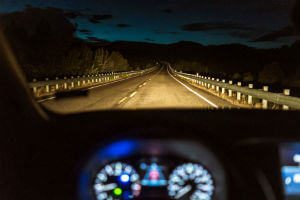Tips for Driving Safely at Night
 Nighttime driving conditions can be dangerous because visibility is substantially impacted by reduced light. Driving in the dark increases car accidents, due to difficulty judging distances, reduced depth perception and temporary blindness from headlight glare.
Nighttime driving conditions can be dangerous because visibility is substantially impacted by reduced light. Driving in the dark increases car accidents, due to difficulty judging distances, reduced depth perception and temporary blindness from headlight glare.
Below are tips for staying safe on roadways at night. Being aware of the causes of after-dark accidents and precautions to take when driving at night can help you avoid a collision.
Causes of Nighttime Car Accidents
According to the National Highway Traffic Safety Administration (NHTSA), the number of nighttime car accident fatalities is three times higher than fatalities from daytime accidents.
Common causes of after-dark car crashes include:
- Mobile phone usage: Using a mobile phone takes a driver’s attention away from the road. Your eyes also have to adjust to darkness after looking at a bright mobile phone screen. You may not see potential hazards in time to avoid a crash. Mobile phone use and driving while distracted are more common at night when out with friends.
- Vision issues: Many people experience vision issues at night, even those with great daytime vision. Seeing hazards may be more difficult, and you may not be able to react as quickly as you would during the daytime.
- Driving under the influence: The majority of drunk driving accidents happen after dark. Drivers may be traveling to and from events after drinking throughout the night.
- Rush hour traffic: In some areas, rush hour traffic can last until about 7 p.m. Depending on the time of year, rush hour can extend well after the sun goes down, making it more difficult to see in heavy, congested traffic. Driving during rush hour is especially dangerous because there is more traffic on the road and many drivers are in a rush to reach their destinations.
- Drowsy driving: Not getting enough sleep can cause impairments similar to drunk driving when behind the wheel. Many accidents caused by drowsiness can happen within 25 miles of a driver’s home, showing that drowsy driving can be a problem even on shorter trips.
Nighttime Driving Tips
Drivers should take the following steps to improve the safety of their nighttime driving:
- Always get enough rest before you drive to improve alertness
- Take rest breaks if you get tired while driving – pull over in a safe location to stretch your legs or take a short nap
- Switch driving duties with another well-rested driver if you get tired
- Position your headlights correctly and keep them clean to improve visibility
- If you need glasses, pick lenses with anti-reflective coating to reduce vision strain caused by lights outside
- Keep your windshield, exterior mirrors, and rearview mirrors clean
- When approaching a vehicle using high beams, do not look straight at the oncoming vehicle’s lights – adjust your gaze towards the right edge of your lane instead
California’s Nighttime Driving Rules
Under California law, drivers are required to use their headlights from 30 minutes after sunset to 30 minutes before sunrise. If weather conditions or low visibility requires the use of windshield wipers, headlights must also be used.
Low beam headlights should be used when driving in the rain after dark. Drivers should use high beam headlights on open country roads or dark city streets when permitted. Drivers must dim headlights to low beams within 500 feet of oncoming vehicles, or within 300 feet of a vehicle he or she is following.
Contact Our Car Accident Attorneys Today
If you were injured in a car accident, contact us for a free, no obligation consultation. Our experienced legal team can review your case and inform you of your legal options for pursuing the compensation you deserve. We require no upfront fees and payment is only due if we recover compensation for you.
Contact us today to schedule your free case evaluation. Call (916) 777-7777.
